Total War: Warhammer III is the highly anticipated final entry into the franchise. However, the Total War franchise made its first debut in the year 2000 with the game Shogun: Total War. Since then, the series courted many staunch fans including Henry Cavill of Witcher and Superman fame.
But this game has tons of systems, factions, abilities maps, and game modes to learn about. Let’s break down the game into an in-depth review for long-time fans and newcomers alike.
Total War: Warhammer III background
The Total War franchise has a huge catalog of games in many settings and time periods. But the general mechanics remain the same in principle. Players control and manage resources across turn-based and real-time situations.
The game is not available for any console currently. But players can choose to play on Microsoft Windows, macOS, or Linux computer setups. But beware: it does take up about 120 GB of storage space.
For the first time in the series, there’s a dedicated tutorial – a great addition to attract new players to the franchise. There are tons of controls to learn and TW Warhammer 3 gives players a much more transparent experience to enhance accessibility.
However, many of the additions that newcomers will find helpful will make veterans of the franchise cringe or balk. The developers had this in mind so you can disable all of the help-oriented features at your leisure.
Setting and tone
Defining the setting of Total War: Warhammer III is difficult since there are maps for each faction. However, you could say that the story mode setting is fairly consistent. You have Kislev – the snowy realm, Grand Cathay – a lush yet arid empire, and the realms of Chaos according to four ruinous Gods.
The four Gods are the plague god Nurgle, lord of pain and excess Slaanesh, the “changer of ways” Tzeentch, and god of violence and blood Khorne. Each faction map features unique designs, atmosphere, and music that fits them. The tone can shift wildly as a result with Slaanesh’s settings feeling creepy and suffocating while Nurgle’s realm just makes you really want a bath.
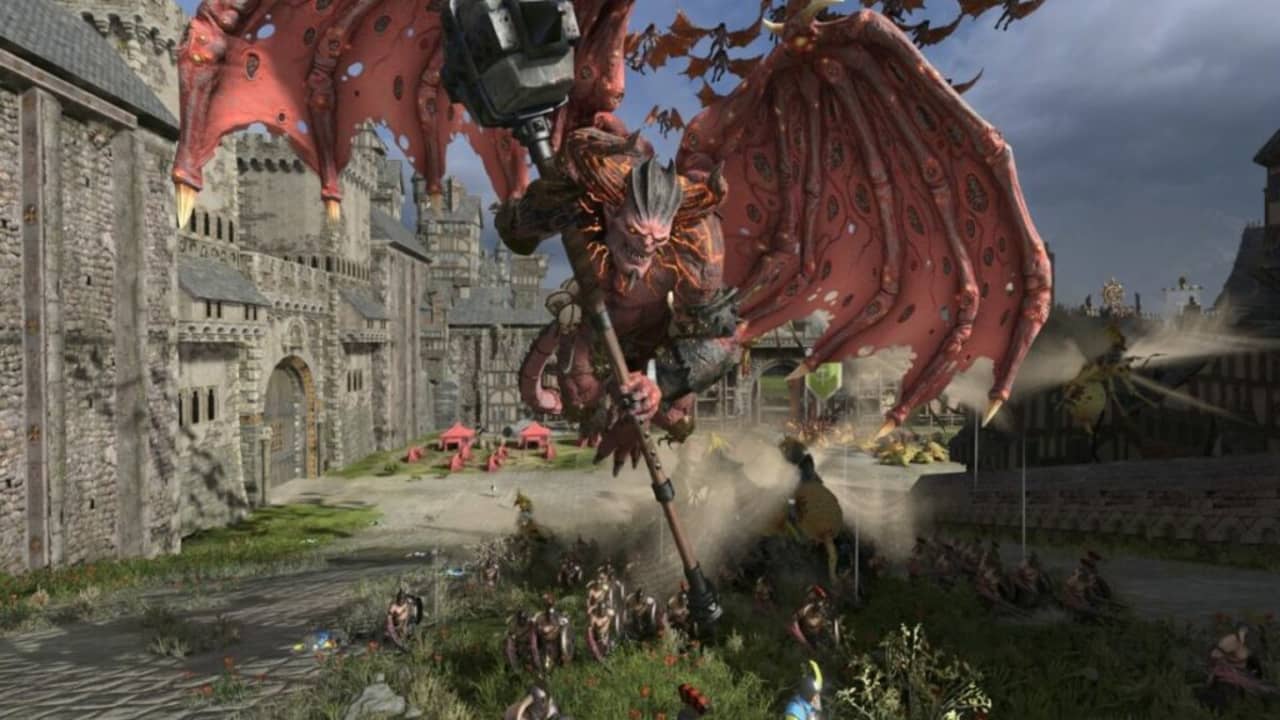
Story
Longtime fans of the Warhammer world will find the story fulfilling and engaging. It centers around preventing the total Chaos apocalypse from coming to the world. Players must claim four daemon prince souls and choose what to do with the bear god Ursun – worshipped by the Kislev peoples.
The tutorial also includes a wonderful storyline about a Kislev Prince named Yuri seeking out said bear god. It serves as a fantastic introduction to the gameplay, but also a great narrative that introduces people to a previously underdeveloped region of Warhammer, setting up the game’s main campaign.
How long to beat Total War: Warhammer III
Obviously, you can’t “beat” multiplayer mode except for winning, losing, or otherwise completing matches. However, how long to beat Total War: Warhammer III boils down to individual playstyle and which faction you choose.
Main Story: ~20 – 30 hours
Main Story and extras: ~40 – 50 hours
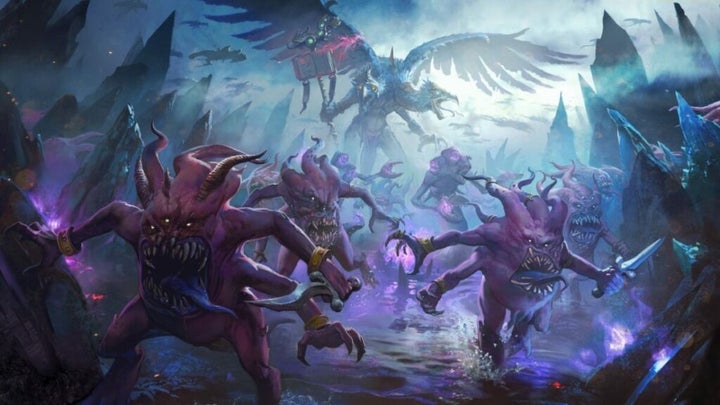
Performance
No game is without its issues and bugs; Total War: Warhammer III has some serious problems, too. Alt-tabbing can cause a crash, certain hardware can interfere with framerates, Game Pass players may not see text in the game...the list goes on.
Outside of these game-breaking issues, the game gets regular balance patches starting with its first patch in mid-March. As with all games that feature individual units with distinct abilities, tweaking damage numbers, health amounts, spell costs, etc. will be an ongoing process.
Potential players with less than high-end computers can still enjoy the game at 720p though. Just remember that you need 120 GB of storage space for the game. That is just one of the things it pays to know before starting the game.
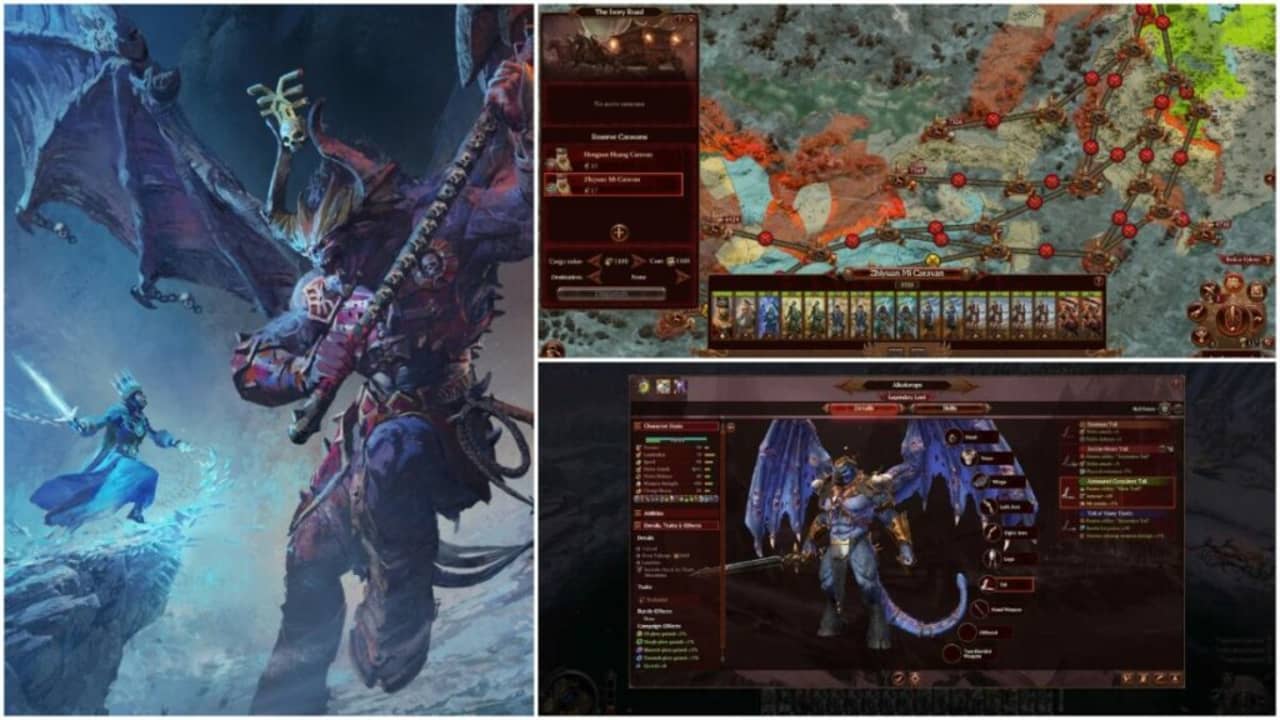
Total War: Warhammer III gameplay and functions
UI and interface
Quality of life changes are the main theme for the UI in Total War: Warhammer III. There are lots of improvements – especially when it comes to single-player mode. However, Creative Assembly made the choice to have a majority red color theme. This may not work for every player.
Many fans of the series were delighted to see a new in-game encyclopedia included. Gone are the days where you had to look things up on a second monitor, cellphone, or alt-tabbed web browser. Instead, you can read about enemy types, units, spells, and more using this feature.
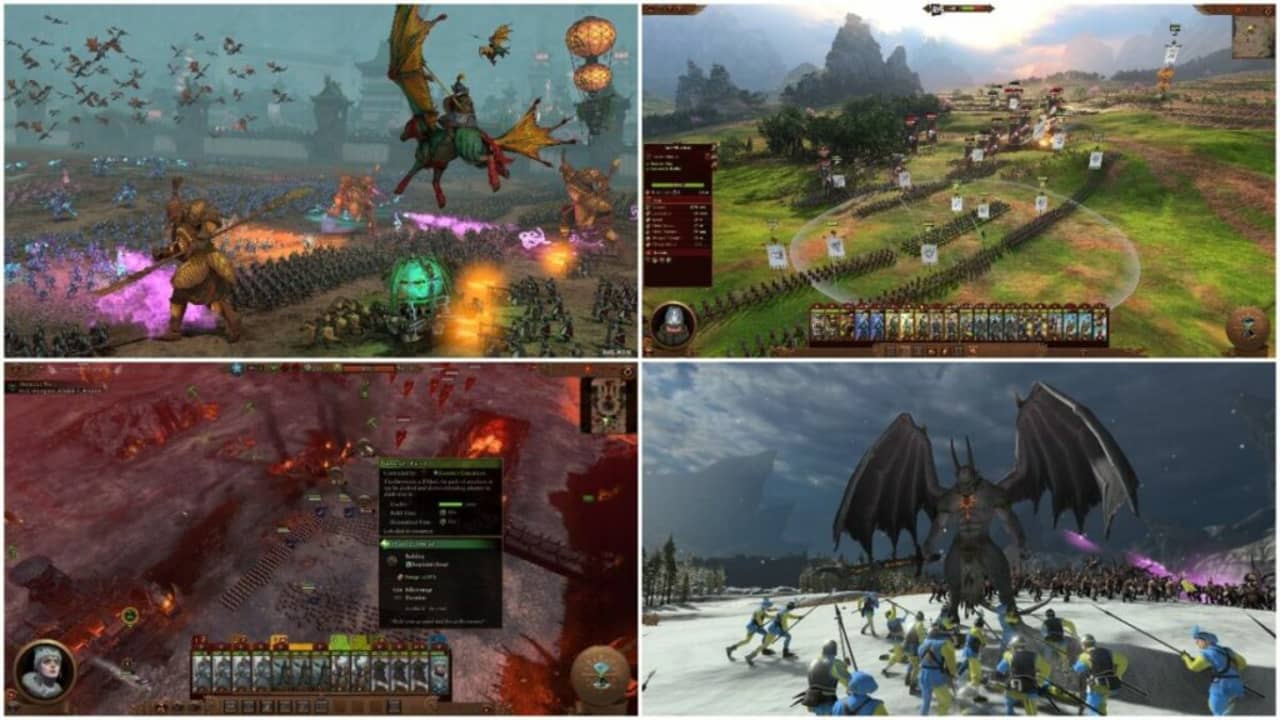
Combat mechanics
Overall, the combat remains very similar to that of previous entries in the series. You control various units in grand campaigns against enemies. However, there are some new inclusions for the latest game. For instance, flying units can take to the sky or attack on the ground.
The good:
- Small UI changes such as the shield icon over units show different states such as being “braced” which helps reduce damage.
- Lazy health bars also enhance damage readability throughout combat.
- The slow-motion casting options make magic much more accessible in the game, as well.
- The Idle Unit hotkey seems especially useful as it can quickly show you any units without orders.
- The new “Favor” system lets you borrow army stacks from allies. This lets you fill any holes you find such as ranged units or heavy units to better build out your armies.
The not so good:
- The AI can be a bit unreliable as they can ignore your directions, get stuck on geometry, or just stay in the same place entirely.
- Sometimes, things that should disappear like battering rams will instead block an entrance you just made instead. It can be a frustrating detriment to the experience.
- Defensive structures don’t seem as effective at repelling enemies as they should.
Total War: Warhammer III factions, heroes, and playstyles
As always, there are tons of character factions in Total War: Warhammer III. Though there are only 8 factions so far, Creative Assembly is sure to add more as time goes on. Let’s break down each faction, their heroes, and the kinds of units and strategies they benefit from most.

Legions of Chaos – don’t talk to me or my dress up demon son Ragnar ever again
Main resource: Daemonic Glory. Use glory gained to worship and honor one of the four Ruinous Gods to unlock more abilities and gear.
Main Hero: Daemon Prince Ragnar
This faction serves as a kind of choose-your-own-adventure situation. But instead, you build a daemon prince named Ragnar who worships a different ruinous power and can be customized in abilities and aesthetics. As you dedicate actions to various Chaos Gods, you’ll receive buffs, war gear, and special units.
From there, you can choose to commit to one God or remain “Undivided” and the game doesn’t really incentivize you to pick just one God. You have access to all units while Undivided and don’t gain access to anything special for trimming down.
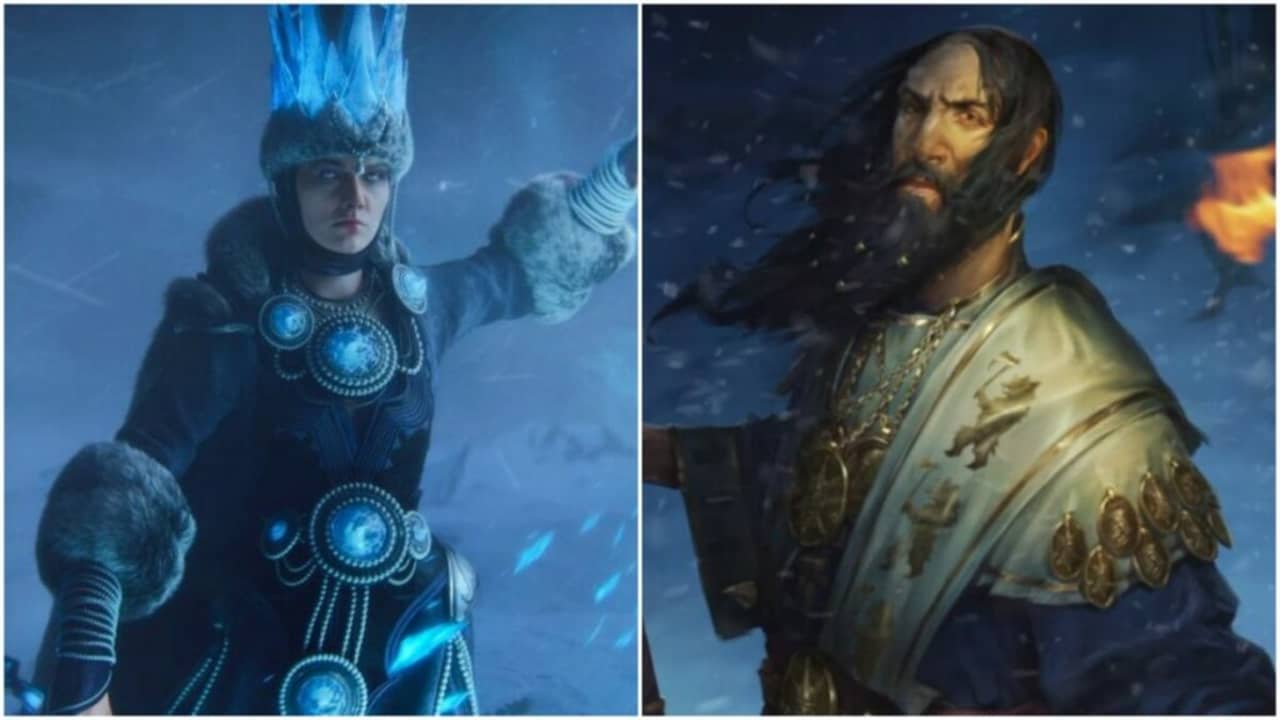
Kislev-bear-god worshipping pseudo-religious warriors and ice mages
Main resource: Devotion. Defeating Chaos armies grants this resource that can be spent to honor one of four deities. However, two sub-factions compete for control within Kislev – the Great Orthodoxy and the Ice Court.
Main Hero: Tzarina Katarin and Kostaltyn of the Great Orthodoxy
Modeled after Russian and Slavic cultures, the Kislev people reside in an extremely snowy landscape. The demanding environment has made its people hard, but it’s the routine interdimensional invasions that keep things interesting. The Ice Witch Queen Katarin faces trouble from the Rasputin-esque Orthodoxy leader Kostaltyn.
From a lore perspective and skill selection, Katarin seems like the optimum choice. Kostaltyn still has access to ice magic even though he views Katarin’s approach as heresy. Despite this odd choice, the Kislev faction is very fun to play with lots of options for gaining supporters, buffs, and more.
Their units serve great hybrid roles, often being able to attack at range and hold their own in melee combat. The heavy units also have handguns for shiggles and the mounted polar bear units can smash epically through smaller units. Then, of course, there’s the new ice magic you have access to, as well.
Players who like to adapt in each battle should try the Kislev faction for lots of variety. Plus, you get a sweet and enormous ice bear if Katarin and Kostaltyn place nicely for long enough.
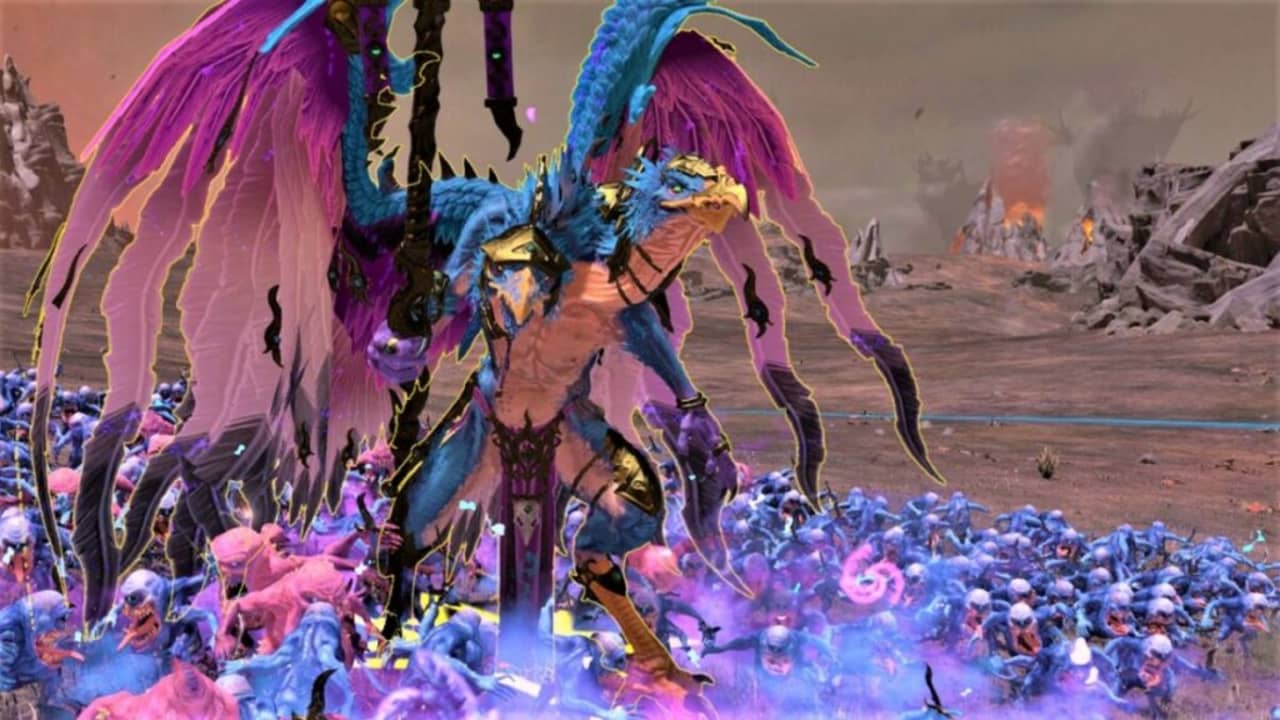
Tzeentch – “tricksy hobbitses, a short story by H.P. Lovecraft”
Main resource: Grimoires. Unlock “Ways of Change” with them to enact diplomatic incidents, spy on others, and generally plot.
Main Hero: Kairos Fateweaver
Like a combination of Ravenclaw and Slytherin, Tzeentch focuses on manipulation, knowledge, plotting, and magic. The faction’s hero Kairos Fateweaver trades in trickery and misdirection with “Changing of the Ways”. Use this to look into the future and play around with faction expectations. This incentivizes players to sow chaos among and within other factions via settlement takeovers.
The units mainly focus on ranged attacks including a unit that resembles a fleshy, beaked arm that slings purple fire. The Lore of Metal takes this to another level causing tons of damage with spells to satisfying ends. But each unit also has an innate shield generator in tandem with HP that benefits from buffs. Once broken, they can also recharge.
The downsides to this faction are its limited variety of units and straightforward combat strategies. Some fans have also called the faction designs for Tzeentch less inspired and unique compared to other factions.
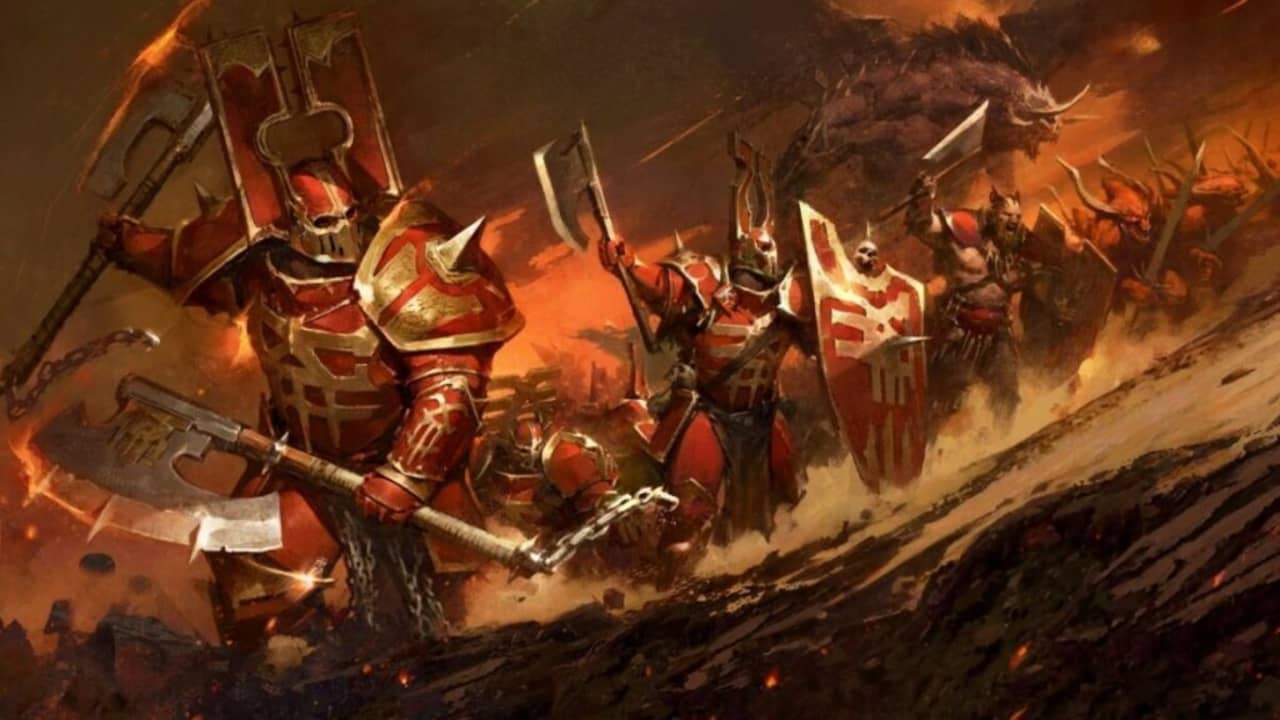
Khorne-battle-obsessed demons with a very simple request: your skull
Main resource: Skulls. Blood for the blood god, but also skulls for the skull throne.
Main Hero: Skarbrand
Known as a god of violence and blood, Khorne’s faction feature Skarbrand as its leader. The savage, demonic-looking giant thrives on the battlefield and he wants to get more skulls for Khorne’s skull throne. If you want to battle, battle, battle, and battle some more, this is the faction for you. However, you can also scavenge battlefields for skulls, as well.
Then, use these skulls to unlock different technologic advancements that make rage more worthwhile. Unlocking more technologies means that blood armies last longer and spawn in larger sizes. But you must keep fighting for these armies to stay spawned.
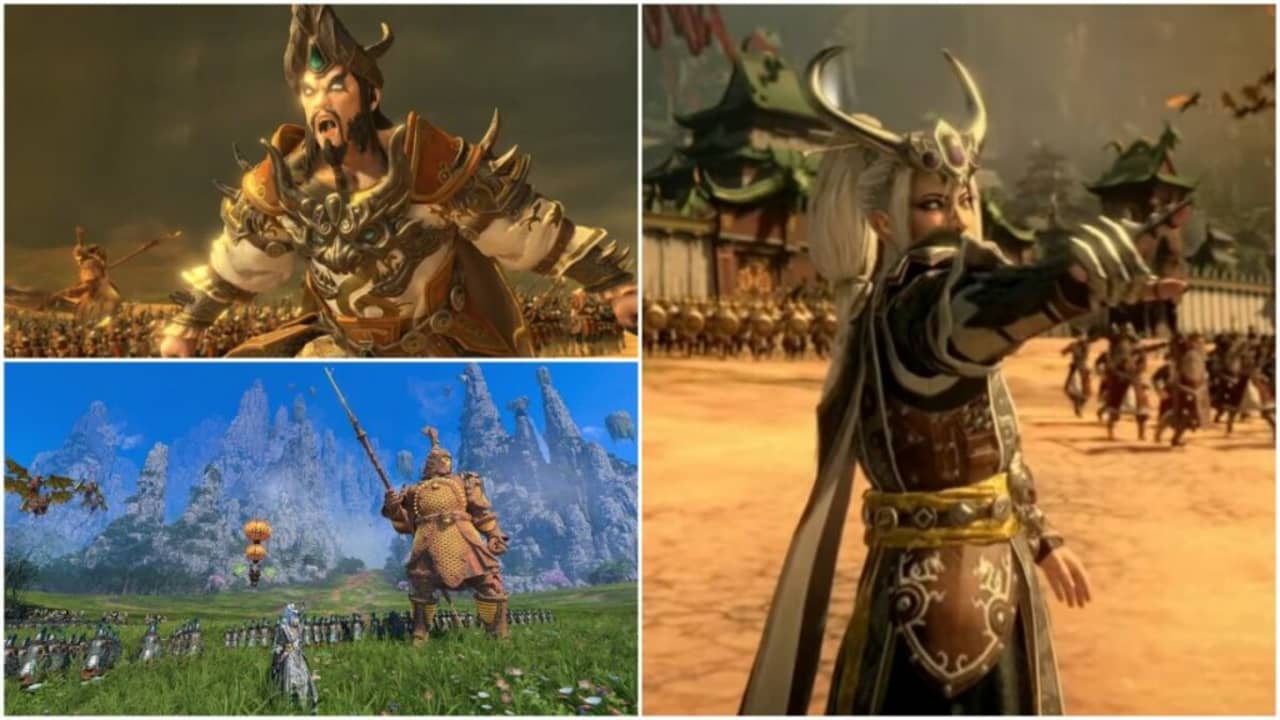
Grand Cathay – everything changed when the Chaos nations attacked
Main resource: None. Instead of using a dedicated resource, players must maintain a balance between Yin and Yang. Choosing abilities and technologies assigns Yin or Yang scores, causing debuffs on your units and buildings if not in balance.
Main Hero: Miao Ying and Zhao Ming
Serving as the largest human empire, Grand Cathay has one of the most unique units available in the form of immortal dragons. Players can control two dragons known as the Storm Dragon or Miao Ying from the Northern Provinces and Zhao Ming or the Iron Dragon ruling over West Cathay and the Sky Road. Canonically, the region prospers despite attacks from Chaos Realms, thanks in part, to the Bastion of Cathay. It’s a bit like the Great Wall of China.
This faction benefits from players who like grand strategies as the Yin/Yang balance mechanic requires more forethought and planning. It also makes use of Trade Caravans for players who like to turtle defensively or reach out via non-violent means. Defending Bastion gates against Chaos forces serves as the main conflict.
Pairing the right units together matters a great deal as many of them are highly specialized. But the faction boasts one of the best special units with the Terracotta General.
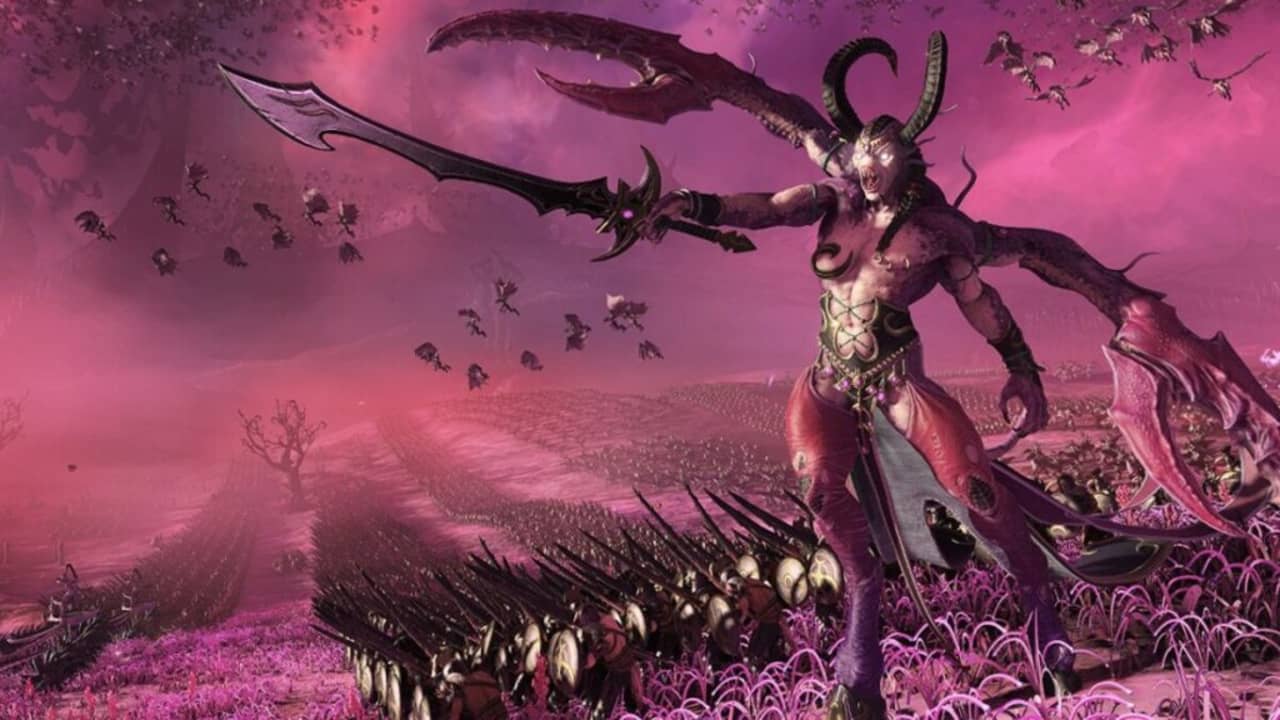
Slaanesh – like MK Ultra but with more leather
Main resource: Devotees. Leverage the power, love, and existence of thralls to collect upgrades and then repeat the process. Recruit others to fight for you since your own units are quite brittle.
Main Hero: N’kari
Led by N’kari (a daemon), the Slaanesh faction serves the god of debauchery and pain. You’ll find mortal followers, daemons, and other creatures in the mix with this faction. On top of quick units, this faction has access to Lore of Shadows magic. Players who favor debuffs, area of effect spells, and an overpowered giant slashing attack will like it.
This faction thrives most when you focus on flanking, attacks from the rear, and identifying weak points in opposing forces. Units tend to be very fast, as well, only reinforcing the focus on movement and positioning for the Slaanesh faction. A quick strategy is to corral your enemy into position and then charge them with your cavalry.
On the non-combat side of things, players will want to build influence with other races. They can leverage this to manipulate them until you can mindbreak or overtake them. Then, control these thralls diplomatically and use their units for extra support.

Nurgle – burping, biting, and lots of bodily fluids
Main resource: Plagues. Though not a spendable or even a collectible resource, how you modify your plagues will impact how successful your faction becomes. Infecting other settlements helps you grow your own power and spread more corruption. But this faction also benefits from Unholy Manifestations and cults.
Main Hero: Ku’gath Plaguefeather
Disease is life for Nurgle and Nurgle followers. This faction is all about city growth, plague generation, and infecting other cities. You can even have Nurgle cults unleash random plagues on people and unlock new sub-symptoms. Technology makes it easier to spread plagues, thereby growing your faction power. In addition, you can create custom plagues in your Plague Cauldron after unlocking plague recipes.
In keeping with Nurgle’s themes of the life, death, and rebirth cycle, the faction buildings follow this process, too. This makes it necessary to regularly check up on them as you don’t really know what they might be doing. Growing units can take time, but you can summon them instantly after growth. Players who like to build robust economies can parlay that into fast army recovery.
It’s all about weakening an enemy and sustaining that battle until they can be overtaken. Your army is slow but steady and you have lots of area-of-effect options, so use that to your advantage.
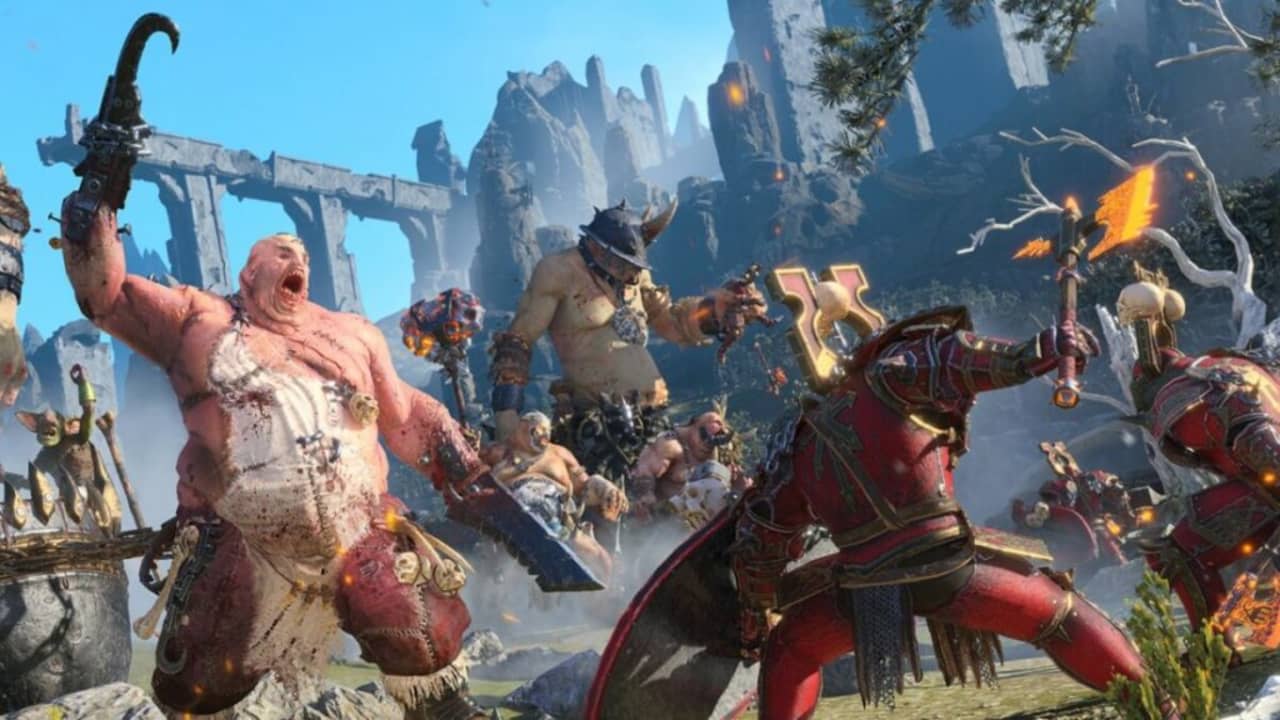
Ogres – smash, gnosh, trash talk, and repeat
Main resource: Meat. Yes, you read that right: meat.
Main Hero: Greasus Goldtooth
Ogres aren’t generally known for their sweeping intellect and that rings true in Total War: Warhammer III. Some have modified arms with giant knives for hands and all of them love to do two things: eat and fight. All of this is done in service to the Great Maw which apparently taught the Ogres magic. In fact, one spell unique to Ogres is “Fist” where a giant gauntlet appears over enemy units and punches down.
This makes them brutal combatants while also being savvy traders, as well. For example, Ogres can take on mercenary contracts from other factions to get extra resources. You can also just raid trade convoys, too. Pro-tip: if Ogres don’t have enough of their unique resource (meat), they will eat each other.
However, this faction does offer more unique customization options for more diverse strategies and playstyles. Charging is the name of the game for Ogres with their large units and heavy attacks.
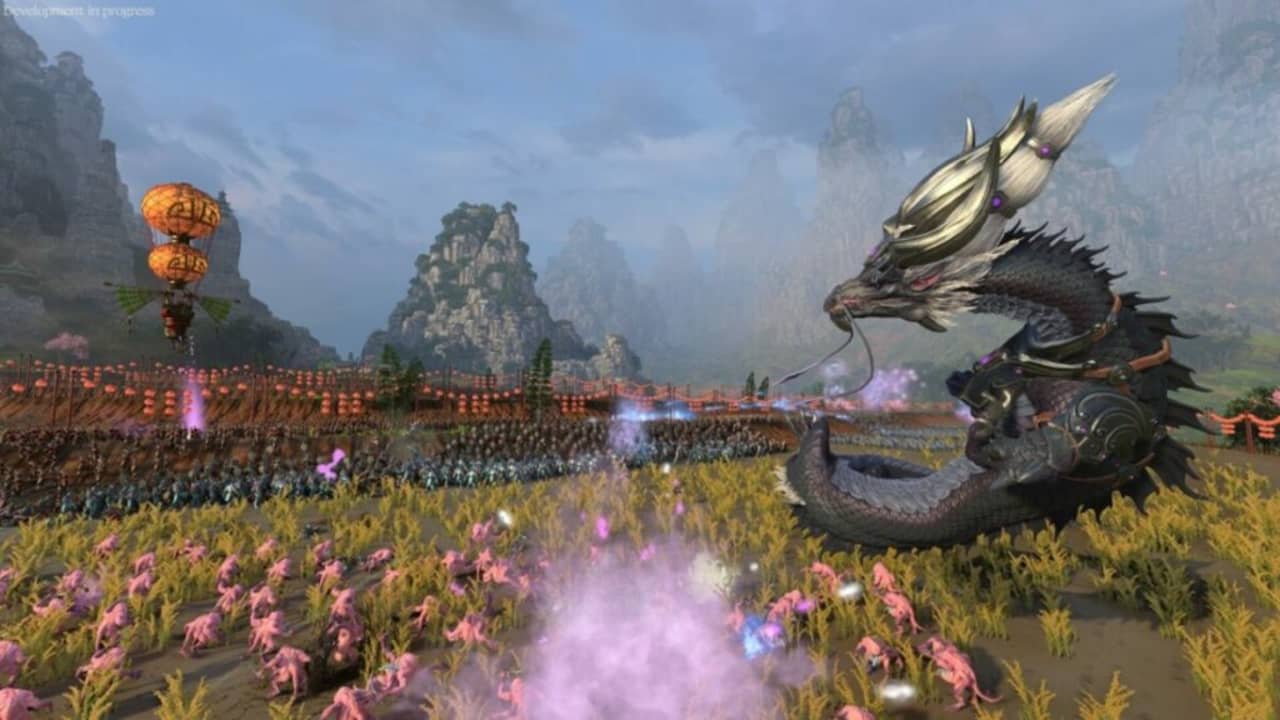
Total War: Warhammer III Game modes
Singleplayer
The singleplayer campaign focuses on the Kislev deity Ursun and his capture. Though many veteran players might skip the tutorial, it is worth playing to get that extra bit of lore and story.
Multiplayer
In comparison to past Total War entries, Total War: Warhammer III has some of the most robust multiplayer features yet. Simultaneous turns represent a huge game-changer, but so does the addition of multiple kinds of multiplayer matches.
Please note: many players have reported issues with multiplayer lobbies, regional disconnects, and lagging. If you’ve encountered bugs, reporting it to the developer is the best option.
Realms of Chaos Mode – Rifts into the Chaos Realms appear across the map, spawning enemies along with distinct problems and challenges from rogue armies to tantalizing rewards if you leave sooner. In order to “win” the incursion, players must battle all enemies, overcome a realm trial, and defeat a Daemon Prince. If you fail, you cannot re-enter the realm until all other rifts come back. Staying in Chaos Realms causes characters to acquire negative traits that impact combat.
Standard Campaign Match – this co-op style of multiplayer has room for up to 8 players to go through the main campaign, siding with various factions along the way. What’s quite cool about this is that you can see your friends make their decisions in almost real-time thanks to simultaneous turns. The only downside is that this approach can cause games to hang while the engine resolves turns.
Darkness and Disharmony – save or doom Grand Cathay from/to the oncoming demonic hordes with up to 8 players. Consider it a territory race with settlements granting a single victory point per turn. Getting to 40 points first fulfills the win condition and ends the game.
Something Rotten in Kislev – designed for just 1 to 3 players, this game mode has players defending Kislev from demon armies for a simpler, shorter campaign.
Immortal Empires – this “mega campaign” evolved from Total War: Warhammer II’s “Mortal Empires” mode. It combines maps and factions from other games. While not available at launch, Creative Assembly said it will be made available soon.
Ranked – play against other players in a competitive mode with a ranking system.
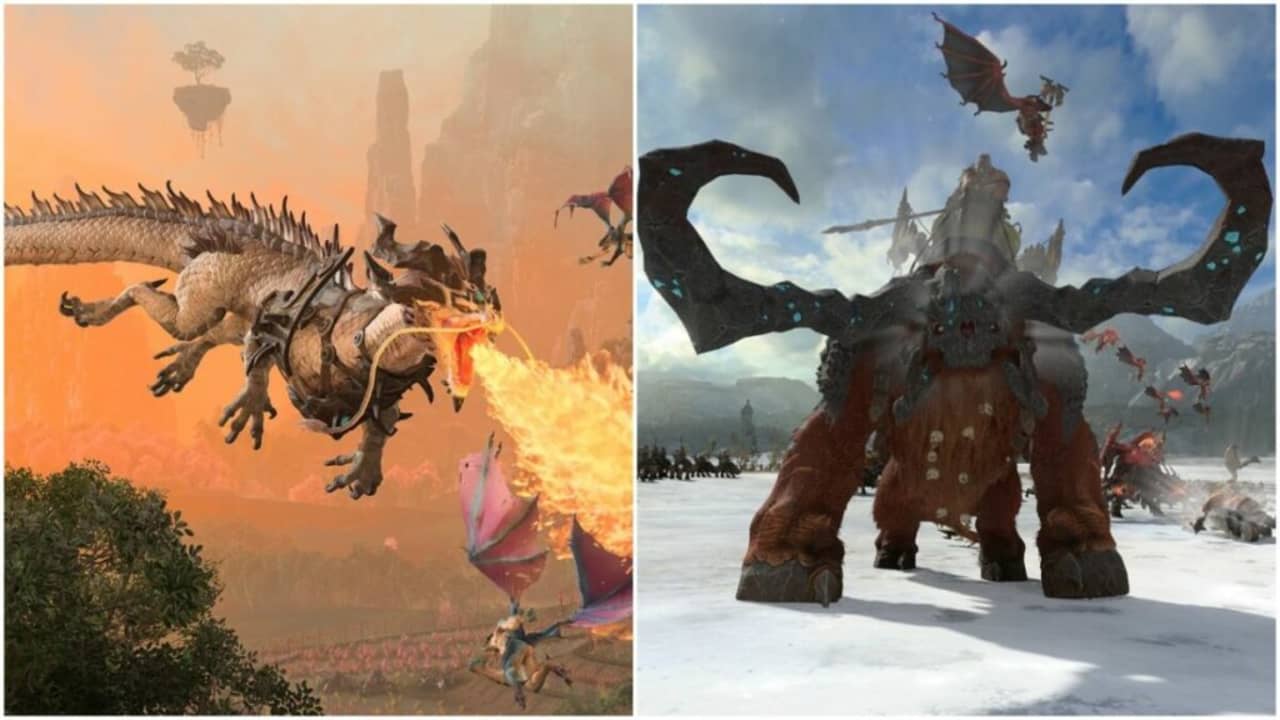
Visuals, sound, and enemy design
Sound design
Music and combat sounds can take a game from a fun experience to a work of art. When it comes to a game in the Total War franchise, this matters even more considering players traverse multiple realms and countries of the Warhammer universe. That said, this game’s sound design makes for an exceptional experience when wearing headphones.
Panning around the battlefield has shouts, screams, and the clashing of weapons grow and fade. The hooves of horses, crunching of bones, and even General speeches can be heard clearly. It’s just one more feature that helps to immerse players in the world experience.
In contrast, the music in Total War: Warhammer III remains more in the background as with previous entries in the franchise. But there is a greater variety of music across factions that adds excitement and diversity. Across the whole Total War series, Total War: Warhammer III has some of the best music and sound design so far.
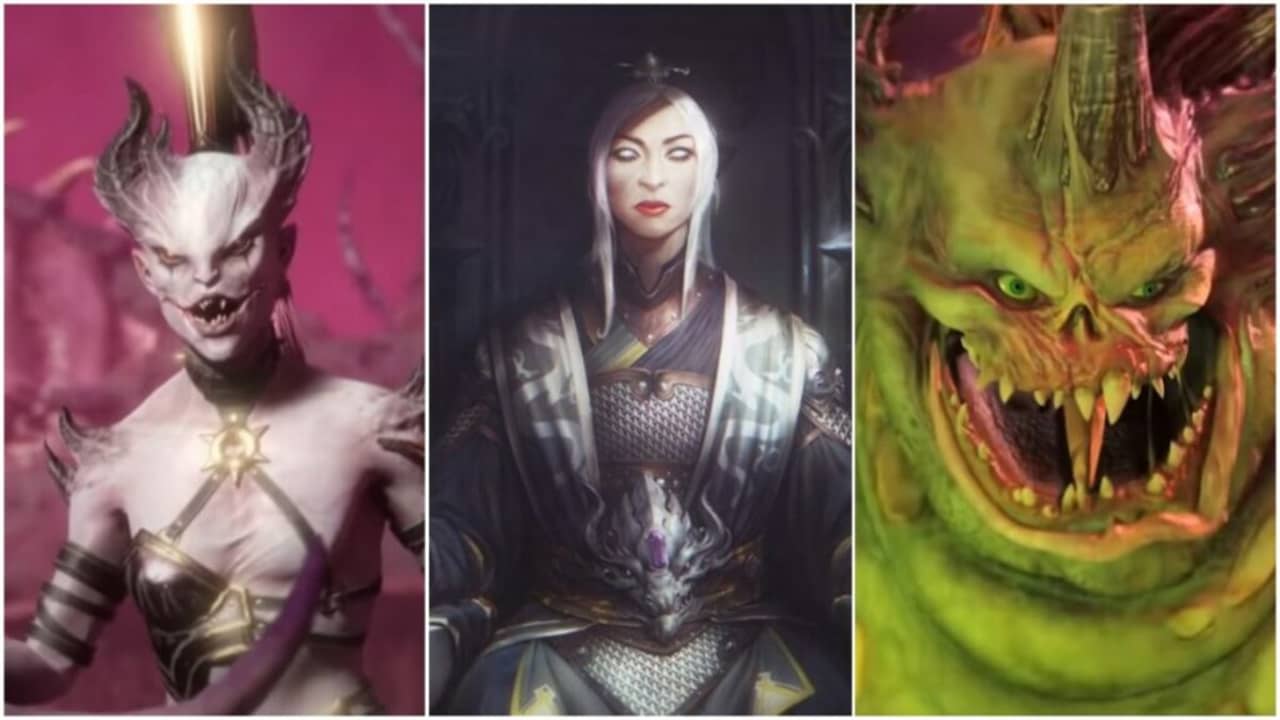
Enemy design
Total War games always feature many original and tailored character designs. But given the fantastical nature of the Warhammer universe, the units in the game tend to feature more…esoteric traits.
For instance, N’Kari, the Slaaneshi Hero, has cloven feet and a mixed-gender body. But then you’ve got Ragnar who has thousands of potential visual combinations.
This third entry in the franchise took many old unit designs and animations to the next level. Things like Nurglings have tons of unique animations from idling to combat while creatures from the Ogres toss around huge artillery cannons like they’re feather dusters.
However, some of the mortal followers feel like afterthoughts in comparison to the more fantastical units.

World design
This new entry employs a different art style than the previous entry. As MandaloreGaming noted in his lengthy review of the game, certain elements and color palettes can read “cartoony” in comparison. However, many of the changes do make it easier to digest visual information on the map more quickly.
Each faction has unique maps and the battle maps are incredible. Creative Assembly wanted players to feel the scale of these realms – chaotic or not – and they did a great job of establishing that grandeur for each faction. As an example, city grids are nowhere near as common for sieges and different races now have more distinct building styles.
You might have a methodical Dwarf map vs. a haphazard Orc map or a winding Vampire map vs. a defensive Empire map. That said, as beautiful and full as many of the maps are, there are very few environmental combat variables.
For instance, the realm of Nurgle has poisonous swamps, but your units don’t have to deal with poisonous gas damage. Including these kinds of environment-based variables could really improve and increase the number of viable strategies in battle.
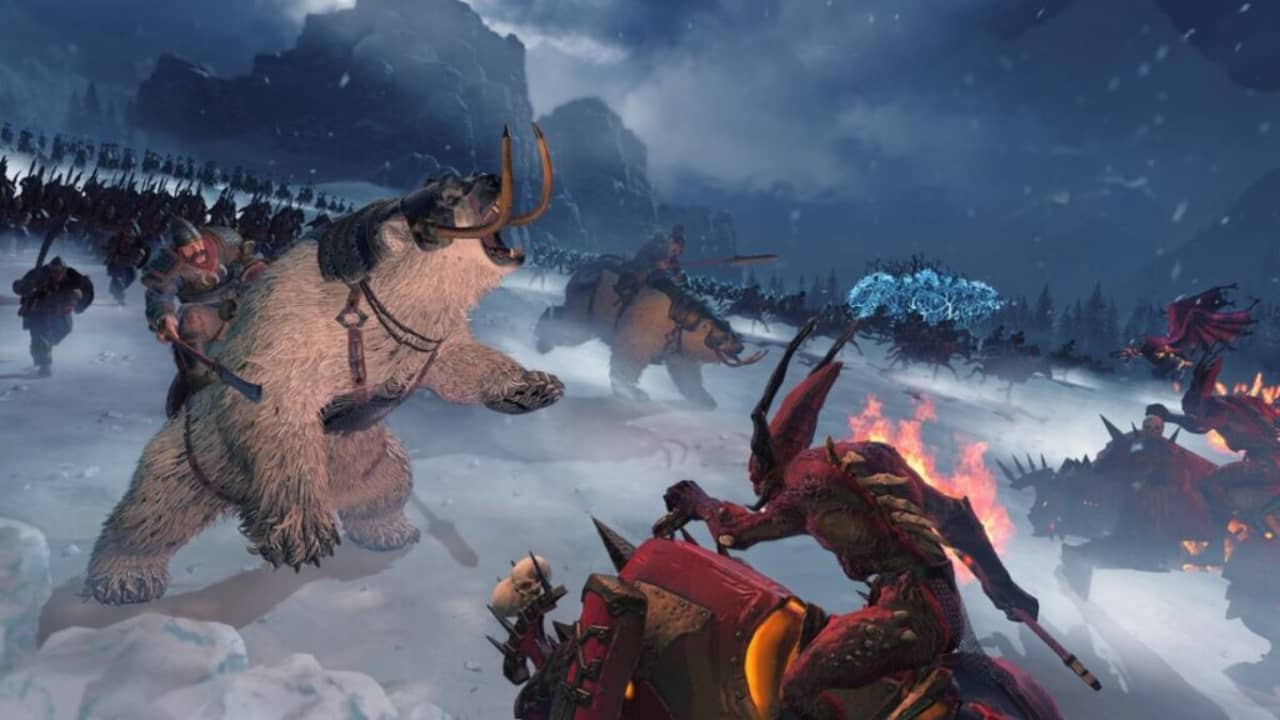
Total War: Warhammer III Review: verdict and wrap-up
More of a good thing is never bad. Total War: Warhammer III delivers exactly that with a few changes here and there. The new factions make wonderful additions to the catalog with fans already clamoring for more updates and factions.
If you loved the previous game, get Total War: Warhammer III. If you are a newcomer to the hybrid turn-based and real-time strategy genre, this offers a good introduction with its dedicated tutorial. However, veteran players may still find the unreliable AI, bizarre UI changes, and inconsistent designs irksome.
Download the game today and see if you have what it takes to fight off the chaotic storm.
PROS
- Many quality-of-life features were added over previous titles in the franchise
- Dedicated tutorial for beginners
- Unique animations for factions and unit types
- Sweeping, huge, and distinct battle maps for different factions
- Lots of game modes
- Fantastic sound design, music, and voice acting
- Great potential for LAN parties
CONS
- Can be difficult for newcomers
- Some factions are locked behind paid DLC
- Difficult-to-read UI at times due to similar color themes
- Redundant UI elements that can lead to disorganization or confusion
- Inconsistent unit and faction design
- Current players report game-breaking bugs
Developer: Creative Assembly
Publisher: Sega
Game Modes: Single-player and multiplayer
Game Engine: Warscape Engine


